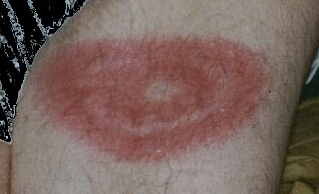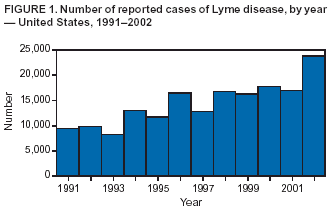
A typical picture showing the Lyme disease infection(above) and transmitting tick (below)
Symptoms
The Lyme disease bacterium can infect several parts of the body, producing different symptoms at different times. Not all patients with Lyme disease will have all symptoms, and many of the symptoms can occur with other diseases as well. The first sign of infection is usually a circular rash called erythema migrans or EM. This rash occurs in approximately 70-80% of infected persons and begins at the site of a tick bite after a delay of 3-30 days. A distinctive feature of the rash is that it gradually expands over a period of several days, reaching up to 12 inches (30 cm) across. The center of the rash may clear as it enlarges, resulting in a bull’s-eye appearance. It may be warm but is not usually painful. Some patients develop additional EM lesions in other areas of the body after several days. Patients also experience symptoms of fatigue, chills, fever, headache, and muscle and joint aches, and swollen lymph nodes. In some cases, these may be the only symptoms of infection.
Treatment
Most cases of Lyme disease can be cured with antibiotics, especially if treatment is begun early in the course of illness. However, a small percentage of patients with Lyme disease have symptoms that last months to years after treatment with antibiotics. These symptoms can include muscle and joint pains, arthritis, cognitive defects, sleep disturbance, or fatigue. The cause of these symptoms is not known. There is some evidence that they result from an autoimmune response, in which a person’s immune system continues to respond even after the infection has been cleared.
For details on long term treatment trials sponsored by NIH visit the NIH Lyme Disease web site.
To read treatment guidelines developed by the Infectious Disease Society of America, click here (IDSA Guidelines for Treatment of Lyme Disease/PDF 120KB, 114 pages).

Incidence of Lyme disease per 100,000 population, by county of residence – United States, 2002. (Source: www.nathnac.org/travel/factsheets/lyme.htm)
Effect of Andrographis on Lyme disease
There are evidences for curing other spirochetal infections such as Leptospirosis through treatment using herbs like Andrographis. Extract of this herb, in the form of an injection or tablets of the crude extract or of the isolated lactones, was reported to effectively treat leptospirosis. In one evaluation, 31 of 35 cases were said to be cured by the Andrographis lactones. There are people who had used Andrographis treating the Lyme disease (Andrographis is the best all around herb for Lyme!). [Caution: There could be allergic reactions. Read http://www.amazon.com/Healing-Lyme-Prevention-Borreliosis-Coinfections/dp/0970869630].
AT THE MOMENT, THERE ARE NO SCIENTIFICALLY VALIDATED REPORTS REGARDING THE EFFICACY OF ANDROGRAPHIS IN TREATING THE LYME DISEASE. However, the effects of herbs like Andrographis can not be ruled out altogether. There may be effects which really works to many diseases for may people. Traditional systems of medicine will help us even without scientific validations. Let us learn from traditional knowledge and people's experience in using herbs for treating diseases.

Number of reported cases of Lyme disease in US from 1991 to 2001
Research Findings
- MMW Fortschr Med. 2006 Jun 22;148(25):32, 34, 36. [Early diagnosis of Lyme borreliosis] [Article in German] Hofmann H. Klinik und Poliklinik fur Dermatologie und Allergologie der TU Munchen. h.hofmann@lrz.tum.de
The local inflammatory reaction following a tick bite varies considerably, so that in particular the frequently atypical variations result in a wrong diagnosis and thus to inappropriate treatment. If a tick bite is followed within three weeks by flue-like or neurological symptoms, or joint swelling in the vicinity of the bite, a serological investigation work-up should be carried out. In the early stage, however, Borrelia-specific antibodies can be detected in only 30-80% of the patients. However, during the further course of the illness, the specific IgM and IgG antibody titers almost always increase. PMID: 16859158 [PubMed - indexed for MEDLINE] - 2: MMW Fortschr Med. 2006 Jun 22;148(25):30-2. [Ticks, tick bites and how best to remove the tick] [Article in German]
Fingerle V, Wilske B. Nationales Referenzzentrum fur Borrelien, Max v. Pettenkofer Institut, LMU Munchen. nrz-borrelien@mvp.uni-muenchen.de
As a rule, the tick, Ixodes ricinus, is picked up when its victim walks through low vegetation and brushes it off a leaf or blade of grass. Often hours later, the tick scores the skin at the site it selects and then pushes its barbed hypostome into the tiny wound to anchor itself to its victim with the aid of a cement-like substance and the barbs. While it sucks up blood, Borrelia burgdorferi spirochetes pass out of the tick's intestine into its salivary glands and thence into the host. It is therefore of decisive importance that the tick be removed with a special forceps as early as possible. The use of such substances as glue, alcohol or nail varnish to remove the tick must be discouraged. Currently, antibiotic prophylaxis, examination of the tick for the presence of B. burgdorferi, or serological follow-up tests are not recommended. PMID: 16859157 [PubMed - indexed for MEDLINE]
New Lyme Disease Guidelines Spark Showdown (11/09/2006, HealthDay)
Long-Term Antibiotics Won't Fight Lyme Disease (10/22/2006, HealthDay)
Lyme Disease - The Facts, the Challenge (National Institute of Allergy and Infectious Diseases) - Large PDF file
Lyme Disease (American Academy of Family Physicians)
Also available in: SpanishLyme Disease (National Center for Infectious Diseases)
Lyme Disease (Mayo Foundation for Medical Education and Research)
Lyme Disease
 (Patient Education Institute) - Requires Flash Player
(Patient Education Institute) - Requires Flash Player
Also available in: Spanish
Lyme Disease Test (American Association for Clinical Chemistry)
Lyme Disease: A Patient's Guide, Diagnosis (American College of Physicians)
Lyme Disease: A Patient's Guide, Treatment (American College of Physicians)
Insect Repellent DEET (Environmental Protection Agency)
Lyme Disease: A Patient's Guide, Prevention (American College of Physicians)
Tick Tips: Protect Your Family from Tick-Borne Diseases (Centers for Disease Control and Prevention)
Lyme Disease and Animals (National Center for Infectious Diseases)
Lyme Disease: Health Information for International Travel (National Center for Infectious Diseases)
Neurological Complications of Lyme Disease (National Institute of Neurological Disorders and Stroke) - Short Summary
Tick Removal: A Step-by-Step Guide (Nemours Foundation)
ClinicalTrials.gov: Lyme Disease (National Institutes of Health)
Lyme Disease: A Patient's Guide, Glossary (American College of Physicians)
Arthritis Foundation
Also available in: Spanish
Reported Lyme Disease Cases and Incidence Rate Per State (American Lyme Disease Foundation)
Lyme Disease (Nemours Foundation)
Lyme Disease (Nemours Foundation)
What's My Lyme Disease Risk? (Nemours Foundation)
Also available in: Spanish





